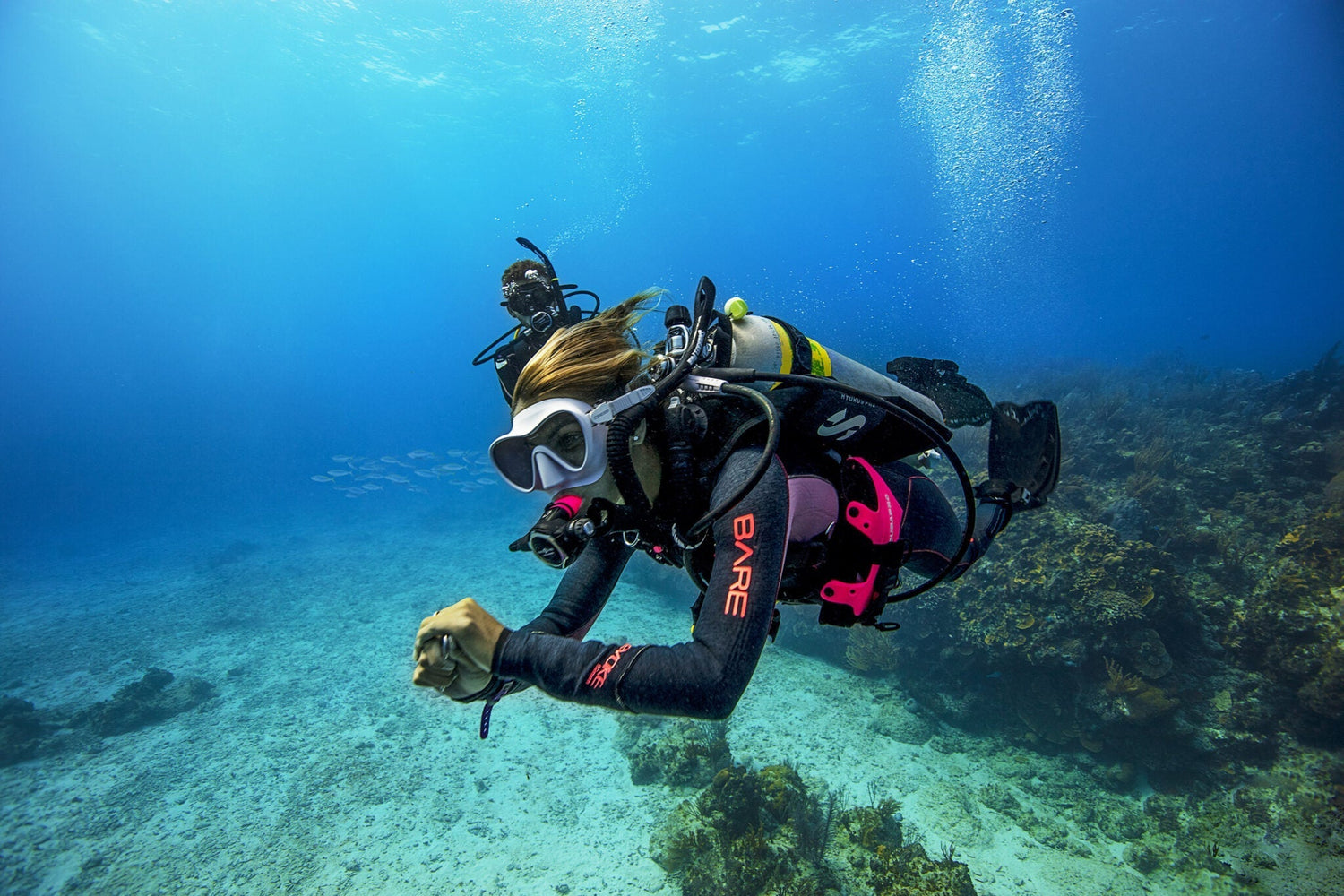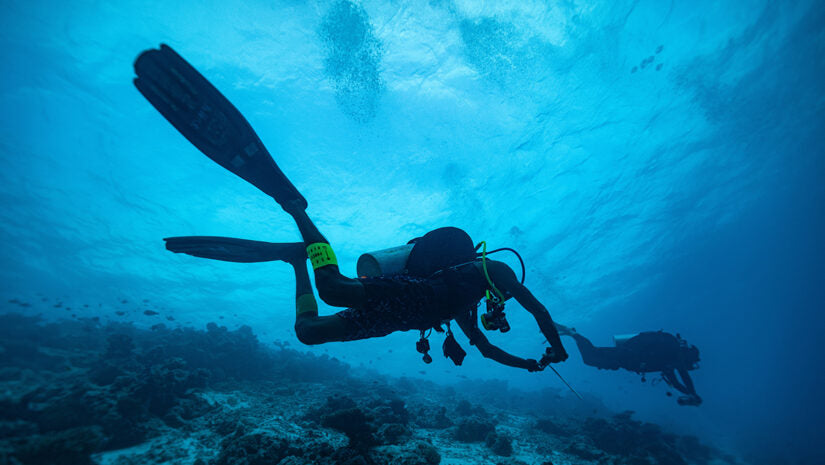Steel dive tanks are 20-30% heavier than aluminum tanks (avg. 30-40 lbs vs. 25-35 lbs) but last 2-3 times longer (20+ years vs. 8-12 years). Aluminum tanks float when empty, while steel sinks, affecting buoyancy control. Steel resists dents better but corrodes if not maintained, whereas aluminum is corrosion-resistant but prone to surface scratches. High-pressure steel tanks (3442 psi) hold more air than standard aluminum (3000 psi), allowing longer dives. Choose steel for durability/performance, aluminum for lightweight convenience.
Weight Comparison
A typical 80-cubic-foot aluminum tank weighs around 31 lbs (14 kg) when empty, while a similar-sized steel tank averages 28 lbs (12.7 kg)—about 10% lighter. However, this changes underwater: aluminum tanks become 2-3 lbs positively buoyant when empty, forcing divers to compensate with extra weight, whereas steel tanks stay negatively buoyant, reducing lead needed by 4-6 lbs.
A high-pressure steel tank (HP120, 3442 psi) weighs 38 lbs (17.2 kg) but holds 20% more air than an aluminum HP100 (3300 psi), which weighs 41 lbs (18.6 kg). For travel, aluminum’s lighter dry weight (e.g., 24 lbs for a compact AL63) is easier to carry, but steel’s lower in-water weight improves trim and reduces fatigue on long dives.
Key Factors in Weight Differences
-
Material Density
- Steel is 2.5x denser than aluminum (7850 kg/m³ vs. 2700 kg/m³), but tanks use thinner walls (e.g., 0.24" vs. 0.43"), keeping steel lighter overall.
- Aluminum tanks need thicker walls to handle pressure, adding bulk.
-
Buoyancy Shift
- A full AL80 weighs 6 lbs more in water than empty; a steel HP80 gains just 1.5 lbs.
- Divers using aluminum often need 5-8 lbs extra lead to offset tank buoyancy.
-
Travel vs. Performance
- Aluminum wins for portability (e.g., AL19 pony bottle: 8.5 lbs vs. steel’s 11 lbs).
- Steel’s negative buoyancy improves stability, especially in strong currents.
Weight Impact on Dive Gear
- Backmount vs. Sidemount: Steel’s density helps sidemount divers balance tanks easier.
- Weight Belts: Aluminum users often need 2-4 lbs more lead than steel divers.
- Airline Fees: Aluminum’s lighter dry weight can save $50–100 in baggage costs on flights.
Practical Choice?
- Cold Water/Technical Dives: Steel’s lower in-water weight and higher capacity (e.g., HP130: 130 cu ft at 42 lbs) make it ideal.
- Warm Water/Recreational: Aluminum’s cheaper upfront cost (500 for steel) and travel ease appeal to casual divers.
Bottom Line: Steel’s weight efficiency underwater often outweighs aluminum’s dry-weight advantage—unless you prioritize portability or cost.
Tank Lifespan
Steel tanks typically last 20–30 years with proper care, while aluminum tanks average 10–15 years before needing replacement. The difference comes down to fatigue life—steel can endure 50,000+ fill cycles before stress cracks become a concern, whereas aluminum weakens faster due to metal fatigue after 20,000–30,000 fills. Corrosion is another factor: aluminum resists rust but develops pitting and thread wear over time, while steel tanks can corrode internally if not dried properly but outlast aluminum structurally.
Why Steel Tanks Last Longer
Steel’s higher tensile strength (60,000–100,000 psi vs. aluminum’s 45,000 psi) allows thinner walls that flex less during pressure cycles, reducing fatigue. A well-maintained steel tank passes hydrostatic testing (required every 5 years) for decades, while aluminum tanks often fail earlier due to wall thinning or neck cracks. For example, a Luxfer aluminum tank might show 0.1mm/year material loss in saltwater, whereas a Faber steel tank loses <0.05mm/year under the same conditions.
Aluminum’s Weak Points
Aluminum tanks degrade faster in high-use environments (e.g., dive shops filling them 5–10 times daily). The 6061-T6 alloy used in most tanks loses 10–15% strength after 15 years, and neck threads wear out 2–3x faster than steel. In warm climates, aluminum’s thermal expansion rate (23 µm/m°C vs. steel’s 12 µm/m°C) accelerates fatigue. A rental aluminum tank might last just 8 years with heavy use, while a personal steel tank could see 25+ years with annual visual inspections.
Maintenance Impact on Longevity
- Steel tanks require internal coatings (e.g., epoxy) to prevent rust. A $150–300 recoating every 10–15 years extends life.
- Aluminum tanks need thread lubrication and anodizing checks to avoid galvanic corrosion. Saltwater exposure cuts lifespan by 20–30% if not rinsed.
- Visual inspections ($20–50/year) catch early cracks. Steel’s thicker neck absorbs damage better—a dent under 0.5" deep might be acceptable, while aluminum fails at 0.3".

Buoyancy Differences
An empty aluminum 80 (AL80) tank becomes +3.1 to +3.5 lbs positively buoyant, forcing divers to compensate with extra weight on their belt or BCD. In contrast, a steel tank of the same capacity (e.g., HP80) remains -2 to -4 lbs negatively buoyant even when empty, reducing the need for additional lead by 4–6 lbs compared to aluminum. This shift happens because aluminum is naturally less dense than water (2.7 g/cm³ vs. 1.0 g/cm³), while steel’s higher density (7.8 g/cm³) keeps it sinking.
A full AL80 starts -1.5 to -2 lbs negative due to the weight of compressed air (around 6 lbs of air at 3000 psi), but as you breathe it down, the tank gets lighter. By the time it’s empty, you’ve lost 7–8 lbs of total ballast compared to the start. Steel tanks don’t swing as drastically: an HP100 begins -8 to -9 lbs negative and only gains 3–4 lbs of buoyancy when empty.
Real-World Impact on Diving
- Weight Systems: Divers using aluminum tanks often need 26–30 lbs of total weight (including tank), while steel divers may only need 18–22 lbs—a 30% reduction.
- Trim & Stability: Steel’s consistent negative buoyancy helps maintain horizontal trim without constant BCD adjustments. Aluminum tanks can cause feet-heavy positioning as they float upward.
- Sidemount Diving: Steel’s density makes it easier to balance two tanks—each HP100 stays -5 lbs negative, while AL80s shift from -1.5 lbs to +3.5 lbs, requiring constant adjustment.
Saltwater vs. Freshwater Differences
Buoyancy shifts are 5–7% more pronounced in saltwater due to higher density. An AL80 that’s +3.3 lbs buoyant in freshwater becomes +3.5 lbs in saltwater, while a steel HP80 goes from -3.1 lbs to -3.3 lbs. This is why steel tanks are favored for ocean diving—their negative buoyancy offsets the saltwater’s lift.
Cost of Buoyancy Compensation
Since aluminum tanks require extra lead, divers often spend $50–100 on additional weight pouches or belts. Over time, steel’s efficiency saves money—fewer lead weights mean lighter travel bags (saving airline fees) and less strain on your back.
Dent & Corrosion Resistance
Steel tanks resist dents better—they can handle impacts up to 0.5 inches deep before failing hydrostatic testing, while aluminum tanks are typically condemned at just 0.3 inches of deformation.
A single missed drying session can lead to 0.1mm/year of material loss in untreated steel. Aluminum doesn’t rust, but it’s vulnerable to galvanic corrosion when paired with dissimilar metals (like brass valves), causing thread erosion that can render a tank unsafe after 8–10 years in saltwater.
Real-World Damage Risks
- Drops & Impacts: A steel tank can survive a 3-foot drop onto concrete with minor scuffs, while aluminum may dent under the same conditions.
- Saltwater Exposure: Aluminum tanks lose 15–20% of their structural integrity after 500 saltwater dives if not rinsed properly. Steel tanks with epoxy liners show <5% degradation in the same conditions.
- Valve Thread Wear: Aluminum’s softer threads wear out 2x faster than steel’s, requiring more frequent inspections.
Maintenance Requirements
Steel tanks need annual visual inspections and internal recoating every 10–15 years (costing $150–300 per service). Aluminum tanks require thread lubrication and anodizing checks to prevent galvanic corrosion. Neglecting these steps can shorten lifespan by 30–40%.
Air Capacity & Dive Time
High-pressure steel tanks (3442 psi) pack 20-25% more air than standard aluminum tanks (3000 psi) of similar physical size. For example, a common steel HP100 holds 100 cubic feet of air while weighing just 34 lbs, whereas an aluminum AL80 holds 80 cubic feet but weighs 31 lbs - meaning you're carrying nearly equal weight for 20% less air capacity.
A steel HP130 delivers 130 cubic feet at 42 lbs, while you'd need two aluminum AL80s (62 lbs total) to get 160 cubic feet. This gives steel tanks a clear advantage for extended bottom times - at 30 meters, a diver using an HP100 gets 15-20 extra minutes compared to an AL80 user with similar air consumption rates. The numbers get even better for technical divers: a twin-set of steel HP120s provides 180-220 minutes of dive time at shallow depths versus 140-170 minutes from comparable aluminum setups.
Real-World Performance Factors
- Pressure Retention: Steel tanks maintain more consistent pressure throughout the dive due to better thermal properties. Aluminum loses 3-5% more air volume as it cools during rapid breathing.
- Buoyancy Impact: That extra air in steel tanks means more weight displacement - about 2-3 lbs of additional buoyancy when full compared to aluminum.
- Gas Efficiency: Technical divers appreciate steel's ability to handle higher oxygen blends (up to 40% nitrox) without special cleaning requirements.
Bottom Line: If you regularly dive deeper than 18 meters or want longer bottom times, steel's air capacity advantage is worth the extra investment.





Leave a comment
All comments are moderated before being published.
Situs ini dilindungi oleh hCaptcha dan berlaku Kebijakan Privasi serta Ketentuan Layanan hCaptcha.